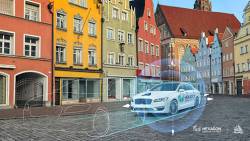Q: What is precise point positioning (PPP), and what are its requirements, advantages and challenges?
A: Precise point positioning (PPP) is a method that performs precise position determination using a single GPS receiver.
This positioning approach arose from the advent of widely available precise GPS orbit and clock data products with centimeter accuracy. These data can be applied to substantially reduce the errors in GPS satellite orbits and clocks, two of the most significant error sources in GPS positioning.
Q: What is precise point positioning (PPP), and what are its requirements, advantages and challenges?
A: Precise point positioning (PPP) is a method that performs precise position determination using a single GPS receiver.
This positioning approach arose from the advent of widely available precise GPS orbit and clock data products with centimeter accuracy. These data can be applied to substantially reduce the errors in GPS satellite orbits and clocks, two of the most significant error sources in GPS positioning.
Combining precise satellite positions and clocks with a dual-frequency GPS receiver (to remove the first order effect of the ionosphere), PPP is able to provide position solutions at centimeter to decimeter level, which is appealing to many applications such as airborne mapping. PPP is different from double-difference RTK (real-time kinematic) positioning that requires access to observations from one or more base stations with known coordinates. The word “precise” is also used to distinguish it from the conventional point positioning techniques that use only code or phase-smoothed code as the principal observable for position determination.
(For the rest of Yang Gao’s answer to this question, please download the complete article using the PDF link above.)
Q: Does Aided-GNSS improve signal acquisition, tracking, or both?
A: A-GPS (Aided/Assisted-GPS) and more recently its extensions, A-GNSS, have been introduced to substitute for missing satellite broadcast data when access is intermittent, difficult, or impossible due to signal obstruction. It has expanded the capabilities of the traditional receiver in reducing the time to first fix (TTFF), enabling “high sensitivity” modes, improving the performance in urban canyons and indoors, and incidentally, boosting the receiver’s efficient use of power.
Multiple ways have been developed to deploy an A-GPS server, and to distribute the process flow between the server and the mobile. The mobile station–based method places the position determination in the receiver, while the network-based method relegates it back to the server.
Other notable factors influence the architecture. The assistance can be one-way, where information accessible at the server flows down to the receiver, or in closed loop, where the information is uploaded to the server, processed remotely applying far larger computational resources and extra knowledge not available to the receiver, and then pushed back to the receiver in its final form.
We will now introduce two simple rules that will illustrate the rest of the explanations:
Rule 1: For A-GPS to be practical, the assistance information should not be stale when ready to be used at the mobile. In more technical terms, the assistance information persistence needs to be longer than the sum of network latency plus server and mobile processing times,
Rule 2: In a closed loop architecture, the information collected at the mobile, and processed at the server should be returned fast enough before the internal state of the mobile changes too much. We can reformulate it as the sum of the round trip network delay plus server and mobile processing times have to be shorter than the process time constant to control the mobile.
(For the rest of Lionel J. Garin’s answer to this question, please download the complete article using the PDF link above.)





